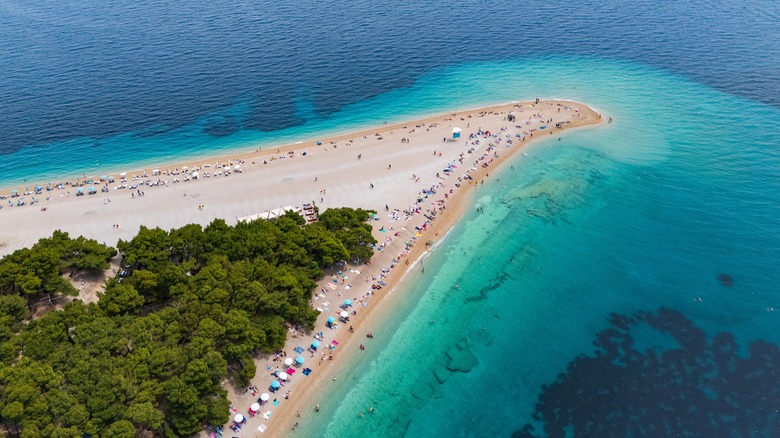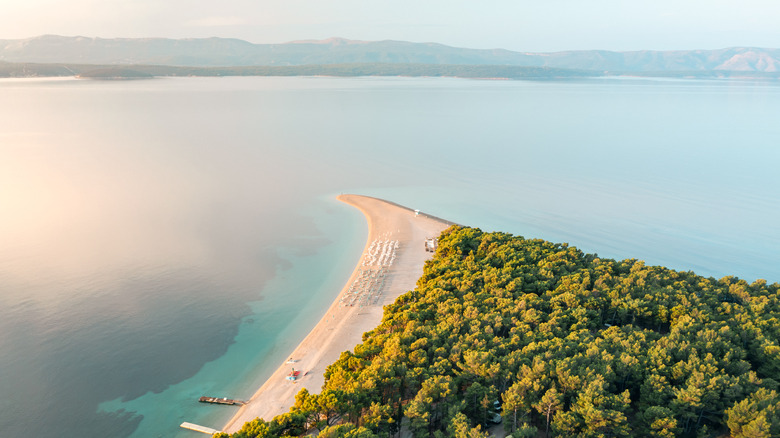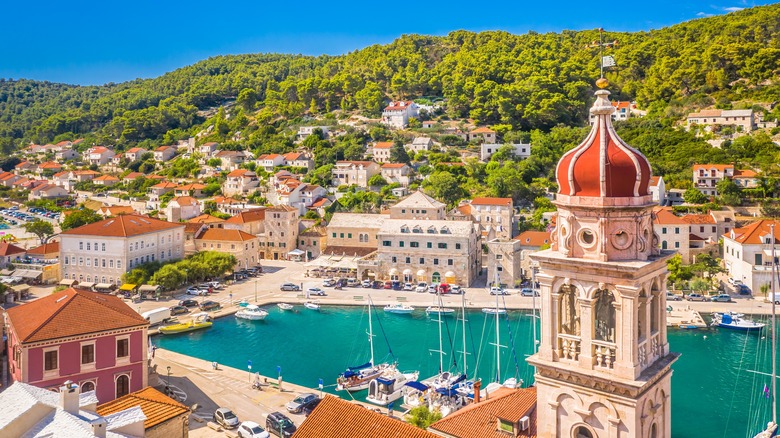Croatia's 'Golden Horn' Beach Is One Of Europe's Popular Spots With Caribbean-Like Waters
The time has passed when Croatia could be considered an underrated European destination. Sure, countries like France, Italy, Spain, and Greece remain more famous vacation spots, and places like the Amalfi Coast, the Côte d'Azur, and the Costa del Sol are still the go-tos for a Mediterranean beach escape. But Croatia is now firmly ensconced as one of Europe's best places to visit, thanks to its gorgeous, crowd-free Istria coastline, glorious Adriatic islands, stunning historical monuments, and relatively affordable costs. It boasts a fantastic combination of sun-drenched beaches, rugged national parks for adventurous thrill seekers, and picturesque coastal cities that give "Game of Thrones" vibes.
One spot that once graced lists with names like 'The Best Secret Beaches' and 'Europe's Hidden Gems' is Zlatni Rat on Brač Island. These days, Croatia's 'Golden Horn' beach is one of the most popular spots for sun-worshippers in Europe, and with good reason. It's a picture-perfect stretch of white-golden pebble beach that sticks out into the turquoise waters of the Adriatic like a tongue, with Caribbean-like waters on both sides of the beach, backed by shaded pines and the rugged, mountainous interior of Brač Island.
Zlatni Rat is on the south coast of Brač Island, looking out towards Hvar. Getting to Brač means arriving in Split, the ancient city on the mainland, and getting a ferry out to Supetar, the main town on the island. From Supetar, you can drive across Brač or take a taxi boat around the island to Bol, a town about a mile from the beach, which can be accessed via pedestrian walkway that hugs the coast. Most people get to Split by air, as its international airport is served by routes across Europe.
Golden pebble beaches and strong, steady winds
Despite the hype and the popularity, Zlatni Rat is still a wonderful place to visit and well worth including on any Croatian or Mediterranean itinerary. It is an eye-catching spot, extending out from the pine groves of the island into the sea, with beaches on both sides of the promontory. The shape of the beach changes with the tides, winds, and currents, meaning that no two visits are alike. The combination of azure-blue water, smooth white pebbles, and dark green pine forests makes for a visually captivating moment, and it's an ideal place to relax and enjoy the scenery.
If peace, serenity, and doing nothing don't do it for you, there's plenty of adrenaline-fueled excitement to be had at Zlatni Rat. Bol is one of Croatia's most famous windsurfing and kitesurfing destinations, thanks to the maestral, a powerful westerly wind that blows all summer long. Veteran windsurfers can rent gear from one of the many shops along the road from Bol to Zlatni Rat, while newbies can get started with lessons or day-long courses.
Zlatni Rat isn't just for adrenaline junkies and sun-worshippers — there's a pleasant middle ground to be found on this excellently equipped Blue Flag beach. There are plenty of boat rental spots where you can rent paddle boards, kayaks, motorboats, or pedalos, complete with their own water slide off the back. There are several tennis and beach volleyball courts on Borak Beach, just a stone's throw away. There's even a ruined ancient Roman villa, hidden under the shade of the pine trees just a few steps away from the pebbles of the beach, which offers an alternative experience for anyone interested in history and culture.
The perfect spot for an off-season escape
During high season, Zlatni Rat can get crowded. It is one of the most famous beaches in Europe, so during summer vacations, it is often wall-to-wall sun-loungers and parasols. This means that it is usually best to visit Croatia's Golden Cape during the off or shoulder seasons. Luckily, the weather in Croatia can be lovely even outside of the summer months, so a trip in April, May, September, or October is a great idea.
This also helps avoid the strongest winds and currents, which is great for those who just want to enjoy the beach, although less ideal for windsurfers and kitesurfers. Zlatni Rat is also one of the few beaches in Croatia where it snows during the winter, so if you want to see something truly unique, a Christmas trip is an alternative and interesting prospect!
The rest of Brac Island is pretty special, so it's worth exploring beyond the beach. A hike up to the top of Vidova Gora is great for outdoor adventurers and gives you the perfect view of Zlatni Rat. The island is filled with exquisite, charming little fishing villages, like Sumartin, Pucisca, and Milna, and it's a great opportunity to enjoy fresh seafood and classic Croatian cuisine in the countless traditional konobas (taverns) dotted around the landscape.


